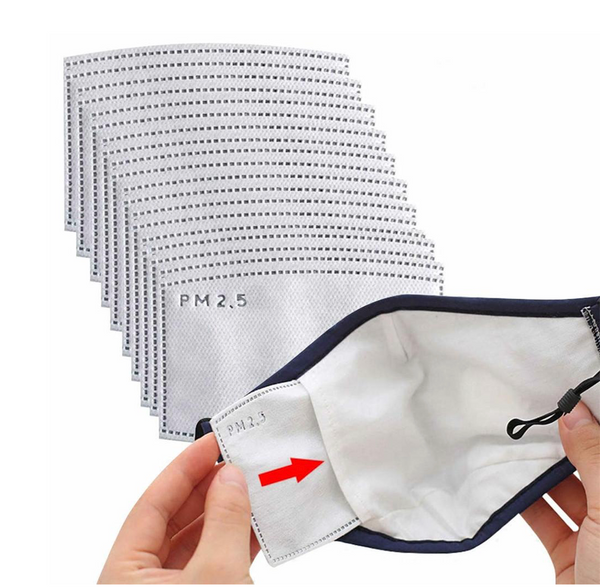Product Overview
Used during the California Fire and Smoke breakout starting August 16, 2020
Order a subscription and we'll send you a set of 20 each month. I'll get direct authorization to send 20 each month.
After the first month, you'll get free shipping should you choose to continue monthly.
These filters are disposable and should be replaced after 1 or 2 weeks depending on how long you are wearing them.
PM25 filter replacements for the polyester/cotton masks and my homemade masks
suitable for the Olson Style mask that has a filter pocket facing the mouth.
- Light and breathable
- Take care to protect your health.
- Size:12x8cm/4.72in x3.15in Suit for mouth mask insided with fliter slot.
- 20 pcs mask filters.
- suggest replace the fliters every week of use for the best effect.
- PM 2.5, ideal to protect your mouth and face from Dust, Haze, Allergies,Smoke,Pollution,Ash, Pollen,Gardening,Crafts.
About PM2.5 filters
Disposable PM2. 5 filters are flat, so they take up less space than standard respirators. They never lose effectiveness, and you can use them continuously for 16-24 hours, around 1 - 2 weeks of occassional use (or whenever it becomes harder to draw a breath).
My best guess is that if you only use your mask during shopping and the amount of time you wear your mask is just 2-3 hours a week, I think you can continue to use it for 2-3 weeks.
Where does PM come from?
The amount of particulate matter in the air at any given time depends on the environment you find yourself in. These particles are released from a variety of sources both indoors and outdoors. When inside, PM levels are typically the same or lower than outside.
Here are a few things that increase the levels of particulate matter floating around an indoor space:
- smoking
- cooking
- burning candles or fires
- using kerosene heaters
- diffusing essential oils
- cleaning using common chemical products
- opening doors and windows to outdoor polluted environments
- using hairsprays, aerosol room freshers or deodorants
Although there are hundreds of sources of outdoor air pollutants, the main contributors that increase the levels of particulate matter outdoors are:
- vehicles
- power generators
- industrial and agricultural emissions
- residential heating and cooking
- the manufacture and distribution of chemicals
- forest fires
Why is it called 2.5?
The 2.5 in PM2.5 refers to the size of the pollutant in micrometres. Bear with us here while it gets a bit mathematics-y! Micrometres have this symbol: µm and are equivalent to 0.001 millimetres. The smallest thing that the average human eye can perceive is about 0.1 millimetres, which is around the same width as a human hair. So in order for us to see something as incredibly small as a micrometre, we need to use powerful microscopes. Here’s
a diagram from the Environmental Protection Agency to help you visualize the scale of these tiny particles.
What are the negative effects of exposure to PM2.5?
Depending on how healthy you are in general, PM2.5 will have different long and short term negative health effects. When exposed to levels of PM2.5 between to moderate – hazardous range, one may experience the following effects:
- shortness of breath
- eye, nose and throat irritation
- excessive coughing and wheezing
- diminished lung function and lung disease
- diminished heart function, sometimes resulting in heart attack
- asthma attacks
- death
PM2.5 also damages the environment by increasing acidity in the soil and water bodies. Which in turn affects their ability to produce food and support life.
What is considered a safe level of PM and how is it measured?
Pollution levels are generally measured on a scale of 0-500 called an Air Quality Index or AQI:






